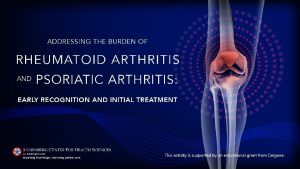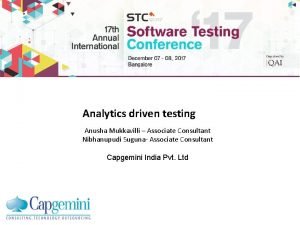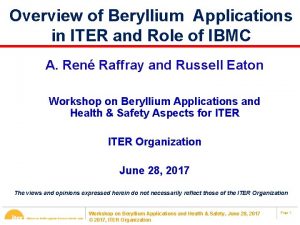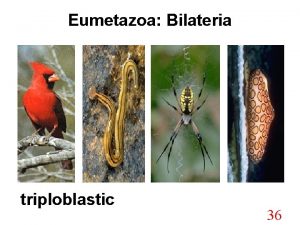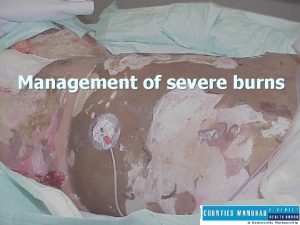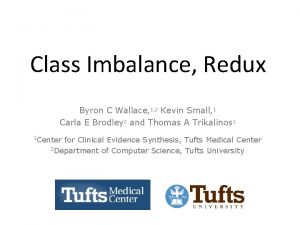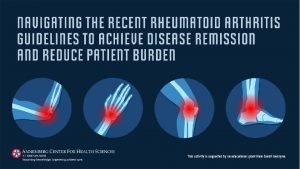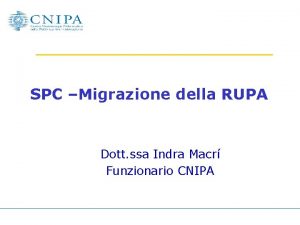Daniel J Wallace MD FACP MACR Associate Director






















































- Slides: 54


Daniel J. Wallace, MD, FACP, MACR Associate Director, Rheumatology Fellowship Program Board of Governors, Cedars-Sinai Medical Center Professor of Medicine, Cedars-Sinai Medical Center David Geffen School of Medicine Center at UCLA In affiliation with Attune Health Los Angeles, California

Disclosures Consultant: EMD, Exagen, Glenmark, Lilly, Serono Clinical area: Lupus

Learning Objectives Describe the overall management, including diagnostic evaluation and initial treatment, in patients with Ps. A or RA. Collaborate with the patient using a shared decision-making approach to better understand patient concerns and inform treatment goals and plan. Perform a diagnostic evaluation, including differential diagnosis and assessment of comorbidities, for patients with possible Ps. A or RA. Individualize evidence-based treatment for treatment-naïve patients with Ps. A or RA consistent with current guideline recommendations. Consider a holistic management approach in patients with Ps. A or RA.

RA and Ps. A Pathogenesis Clinical signs/symptoms IL-17 signaling cascade Macrophage Basophil Mast cell IL-17 IL-1 TGF-β 1 c. AMP/PKA signaling cascade Dendritic Naïve cell T cell IL-12/23 IL-6 IFN-γ IL-21 IL-23 a JAK signaling cascade IL-22 IFN-α MHC TCR IL-1 TNF MAPK signaling cascade Eosinophil Neutrophil Keratinocyte Synoviocyte Osteoclast Osteoblast NFKB signaling cascade Coates LC, et al. Semin Arthritis Rheum. 2016; 46: 291 -304. CD 8+ T cell Pruritus Swelling Skin inflammation? Erosion New bone formation Hyperkeratosis Dermal, epidermal, and synovial inflammation Bone resorption New bone formation Enthesitis

Treatment of RA and Ps. A Core Principles • Treatment should be based on shared decision-making between the patient and the health care provider • Treatment choices should be individualized and based on factors such as disease activity, prognosis, comorbidities, safety, cost, and availability of medications • Treat-to-target should be prioritized, whether that means low disease activity or remission • Overall treatment goals and plan should: § § § aim for lowest possible disease activity optimize functional status improve quality of life minimize structural damage avoid/minimize complications from either active disease or medications Aletaha D. Rheum Dis Clin North Am. 2019; 45: xi-xii; Falzer PR. Int J Rheum Dis. 2019; 22: 1706 -1713; Garrido-Cumbrera M, et al. Rheumatol Ther. 2017; 4: 219 -231.

Rheumatoid Arthritis

Rheumatoid Arthritis Most Common Autoimmune Inflammatory Arthritis in Adults • Onset is insidious, often beginning with fever, malaise, arthralgias, and weakness before progressing to joint inflammation and swelling • Annual incidence is ~40 per 100, 000 • Prevalence is ~1% in Caucasians but varies between 0. 1% (in rural Africans) and ~5% (in Pima, Blackfeet, and Chippewa Indians) • Women are affected 2 to 3 times more often than men • Can occur at any age – Peak onset is between ages 50 -75 Smolen JS, et al. Nat Rev Dis Primers. 2018; 4: 18001; Cross M, et al. Ann Rheum Dis. 2014; 73: 1316 -1322; Mc. Dougall C, et al. Semin Arthritis Rheum. 2017; 46: 675 -686.

Rheumatoid Arthritis Classification Criteria: ACR/EULAR 2010 A Score Of ≥ 6/10 Is Needed For Definite Classification of A Patient as Having RA Joint involvement. A Score 1 large joint. B 0 2− 10 large joints 1 1− 3 small joints (with or without involvement of large joints)C 2 4− 10 small joints (with or without involvement of large joints) 3 >10 joints (at least 1 small joint)D 5 Serology (at least 1 test result is needed for classification) E Negative RF and negative ACPA 0 Low-positive RF or low-positive ACPA 2 High-positive RF or high-positive ACPA 3 A. Joint involvement refers to any swollen or tender joint on examination, which may be confirmed by imaging evidence of synovitis. Distal interphalangeal joints, first carpometacarpal joints and first metatarsophalangeal joints are excluded from assessment. Categories of joint distribution are classified according to the location and number of involved joints, with placement into the highest category possible based on the pattern of joint involvement. B. ‘Large joints’ refers to shoulders, elbows, hips, knees and ankle. C. ‘Small joints’ refers to the metacarpophalangeal joints, proximal interphalangeal joints, second to fifth metatarsophalangeal joints, thumb interphalangeal joints and wrists. D. In this category, at least one of the involved joints must be a small joint; the other joints can include any combination of large and additional small joints, as well as other joints not specifically listed elsewhere (eg, temporomandibular, acromioclavicular, sternoclavicular, etc). D. Negative refers to international unit (IU) values that are less than or equal to the upper limit of normal (ULN) for the laboratory and assay; low-positive refers to IU values that are higher than the ULN but 3 or less times the ULN for the laboratory and assay; high-positive refers to IU values that are more than 3 times the ULN for the laboratory and assay. When rheumatoid factor (RF) information is only available as positive or negative, a positive result should be scored as low-positive for RF. Aletaha D, et al. Ann Rheum Dis. 2010; 69: 1580 -1588.

Rheumatoid Arthritis Classification Criteria: ACR/EULAR 2010 (cont. ) A Score of ≥ 6/10 Is Needed for Definite Classification of a Patient as Having RA Acute-phase reactants (at least 1 test result is needed for classification) F Score Normal CRP and normal ESR 0 0 Abnormal CRP or normal ESR 1 1 Duration of symptoms. G <6 weeks 0 ≥ 6 weeks 1 F. Normal/abnormal is determined by local laboratory standards. G. Duration of symptoms refers to patient self-report of the duration of signs or symptoms of synovitis (eg, pain, swelling, tenderness) of joints that are clinically involved at the time of assessment, regardless of treatment status. ACPA, anti-citrullinated protein antibody; CRP, C-reactive protein; ESR, erythrocyte sedimentation rate. Aletaha D, et al. Ann Rheum Dis. 2010; 69: 1580 -1588.

Rheumatoid Arthritis ACR 2015 Guidelines: Definitions to Know Established RA • RA with duration of disease/symptoms of >=6 months or meeting 1987 ACR RA classification criteria Disease activity • Low, moderate, or high as per validated scales RA remission • A tender joint count, swollen joint count, C-reactive protein level (mg/dl), and patient global assessment of ≤ 1 each or a Simplified DAS of ≤ 3. 3 Optimal dosing of RA treatments • Dosing to achieve a therapeutic target derived from mutual patient-clinician consideration of patient priorities • Given for at least 3 months before therapy escalation or switching Singh JA, et al. Arthritis Rheumatol. 2016; 68: 1 -26.

Rheumatoid Arthritis ACR 2015 Guidelines Instruments to Measure RA Disease Activity and to Define Remission Instrument Thresholds of Disease Activity Remission: 0– 0. 25 Patient Activity Scale (PAS) or PASII (range 0– 10) Low activity: >0. 25– 3. 7 Moderate activity: >3. 7 to <8. 0 High activity: ≥ 8. 0 Remission: 0– 1. 0 Routine Assessment of Patient Index Data 3 (RAPID-3) (range 0– 10) Low activity: >1. 0– 2. 0 Moderate activity: >2. 0– 4. 0 High activity: . 4. 0— 10 Remission: ≤ 2. 8 Clinical Disease Activity Index (CDAI) (range 0– 76. 0) Low activity: >2. 8– 10. 0 Moderate activity: >10. 0– 22. 0 High activity: >22 Singh JA, et al. Arthritis Rheumatol. 2016; 68: 1 -26.

Rheumatoid Arthritis ACR 2015 Guidelines (cont. ) Instruments to Measure RA Disease Activity and to Define Remission Instrument Thresholds of Disease Activity Remission: <2. 6 Disease Activity Score 28 (DAS 28) ESR (range 0– 9. 4) Low activity: ≥ 2. 6 to <3. 2 Moderate activity: ≥ 3. 2 to ≤ 5. 1 High activity: >5. 1 Remission: ≤ 3. 3 Simplified Disease Activity Index (SDAI) (range 0– 10) Low activity: >3. 3 to ≤ 11. 0 Moderate activity: >11. 0 to ≤ 26 High activity: >26 Singh JA, et al. Arthritis Rheumatol. 2016; 68: 1 -26.

ACR 2015 Guidelines Drug Categories: Glucocorticoids (GCs) • Low-dose § ≤ 10 mg/day of prednisone (or equivalent) • High-dose § >10 mg/day of prednisone (or equivalent) and up to 60 mg/day with a rapid taper • Short-term § <3 month treatment Singh JA, et al. Arthritis Rheumatol. 2016; 68: 1 -26; Boers M, et al. Lancet. 1997; 350: 309 -318.

ACR 2015 Guidelines Drug Categories: DMARDs* • Methotrexate (MTX) – Either oral or subcutaneous • Hydroxychloroquine (HCQ) • Leflunomide (LEF) • Sulfasalazine (SSZ) Can be given as mono, double, or triple therapy. *Excludes azathioprine, cyclosporine, minocycline, and gold. Singh JA, et al. Arthritis Rheumatol. 2016; 68: 1 -26.

ACR 2015 Guidelines Drug Categories: TNFi Biologics* • Adalimumab • Certolizumab pegol • Etanercept • Golimumab • Infliximab *Excludes anakirna. Singh JA, et al. Arthritis Rheumatol. 2016; 68: 1 -26.

ACR 2015 Guidelines Drug Categories: Non-TNF Biologics* and Oral JAKi • Abatacept • Rituximab • Tocilizumab • Tofacitinib (oral synthetic small molecule) *Excludes anakirna. Singh JA, et al. Arthritis Rheumatol. 2016; 68: 1 -26.

ACR 2015 Guidelines Treatment of Early RA Regardless of disease activity level: • Use a treat-to-target approach (low disease activity or remission) • use DMARD monotherapy (MTX preferred) If moderate/high disease activity despite DMARD: • Use combo DMARDs or TNFi or non-TNF biologic +/- MTX If moderate/high disease activity despite biologic: • Add low dose GCs (at lowest possible dose for shortest amount of time) Singh JA, et al. Arthritis Rheumatol. 2016; 68: 1 -26.

ACR 2015 Guidelines Early RA Treatment Algorithm Singh JA, et al. Arthritis Rheumatol. 2016; 68: 1 -26.

ACR 2015 Guidelines Treatment of Established RA Regardless of disease activity level: • Use a treat-to-target approach (low disease activity or remission) • Use DMARD monotherapy (MTX preferred) If moderate/high disease activity despite DMARD: • Use combo DMARDs or TNFi or non-TNF biologic +/- MTX If moderate/high disease activity despite biologic: • Add low dose GCs (at lowest possible dose for shortest amount of time) If in remission: • Taper DMARDs, TNFi, non-TNF biologic, or tofacitinib • Do not discontinue all therapy If low disease activity: • Continue DMARDs, TNFi, non-TNF biologic, or tofacitinib rather than discontinuing Singh JA, et al. Arthritis Rheumatol. 2016; 68: 1 -26.

ACR 2015 Guidelines Established RA Treatment Algorithm Singh JA, et al. Arthritis Rheumatol. 2016; 68: 1 -26.

ACR 2015 Guidelines Established RA Treatment Algorithm Singh JA, et al. Arthritis Rheumatol. 2016; 68: 1 -26.

ACR 2015 Guidelines Established RA Treatment Algorithm Singh JA, et al. Arthritis Rheumatol. 2016; 68: 1 -26.

Rheumatoid Arthritis Differential Diagnosis • Viral polyarthritis —rubella, parvovirus B 19, hepatitis B or C, Chikungunya, human T lymphotropic virus type 1 (HTLV-I) • Other systemic rheumatic diseases — systemic lupus erythematosus (SLE), Sjögren's syndrome, dermatomyositis (DM), or overlap syndromes such as mixed connective tissue disease • Hypermobility syndrome and fibromyalgia- no synovitis seen • Reactive arthritis and inflammatory bowel disease (IBD)-associated arthropathy — HLA-B 27 often present • Psoriatic arthritis (Ps. A) • Polymyalgia rheumatica • Crystalline arthritis — gout and pseudo gout • Infectious arthritis — septic arthritis, Lyme disease • Osteoarthritis • Paraneoplastic disease Smolen JS, et al. Nat Rev Dis Primers. 2018; 4: 18001; Aletaha D, Smolen JS. JAMA. 2018; 320: 1360 -1372. Smolen JS, et al. Lancet. 2016; 388: 2023 -2203.

Rheumatoid Arthritis Comorbidities Cardiovascular Disease • Myocardial infarction • Stroke • Atrial fibrillation • Heart failure • Hypertension • Vasculitis Infectious Disease Lung Disease • Chronic obstructive pulmonary disease (COPD) • Interstitial lung disease (ILD) Dougados M, et al. Ann Rheum Dis. 2014; 73: 62 -68.

Rheumatoid Arthritis Comorbidities (cont. ) Osteoporosis Depression Malignancy • Lung cancer • Lymphoma GI ulcerations Eye Disease • Uveitis • Scleritis Dougados M, et al. Ann Rheum Dis. 2014; 73: 62 -68.

Rheumatoid Arthritis Prevalence of Comorbidities Dougados M, et al. Ann Rheum Dis. 2014; 73: 62 -68.

Psoriatic Arthritis

Psoriatic Arthritis CASPAR: Cl. ASsification Criteria for Psoriatic ARthritis Inflammatory musculoskeletal disease (arthritis, spondylitis, enthesitis) with 3 or more points from the following: Evidence of psoriasis: a) Current psoriasis b) Personal history of psoriasis c) Family history of psoriasis 2 1 1 Psoriatic nail dystrophy 1 Negative Rheumatoid Factor 1 Dactylitis (current or recorded by a rheumatologist) 1 Radiographic evidence of juxta-articular new bone formation 1 Taylor W, et al. Arthritis Rheum. 2006; 54: 2665 -2673.

Ps. A Manifestations and Comorbidities Extra-Articular and Extra-Cutaneous Need for teamwork with PCP, Ophthalmology, GI, Psych • • Uveitis (1. 55%)1 Ulcerative colitis (1. 28%)1 Cerebrovascular disease (7. 32%)1 Metabolic syndrome § • • • Obesity (16. 45%), hypertension (47. 28%), hyperlipidemia (47. 47%) 1 Fatty liver/NASH (5. 77%)1 Depression (21. 2%)1, suicidal ideation (0. 48%)1 Fatigue (15. 8%)2 Fibromyalgia (16. 58%)1 Osteoporosis (9. 33%)1 1. Shah K, et al. RMD Open. 2017; 3: e 000588. 2. Kaine J, et al. J Manag Care Spec Pharm. 2019; 25: 122 -132.

Delayed Diagnosis of Ps. A Odds ratio (95% CI) Worse Long-Term Outcomes 11 10 9 8 7 6 5 4 3 2 1 0 * 10. 6 (1. 4– 80. 6) *p<0. 05; **p<0. 01; ***p<0. 001 Association of clinical features† with >6 -month delay in diagnosis (univariate analysis model) *** 4. 6 (2. 5– 8. 2) ** 1. 1 (1. 0– 1. 1) Erosions Number of deformed joints (score) * 2. 3 (1. 2– 4. 4) ** 2. 2 (1. 3– 3. 6) * 0. 4 (0. 2– 0. 9) Sacroiliitis Arthritis mutilans Functional disability (HAQ score) DMARD/anti-TNF free †Clinical features recorded as percent, unless otherwise stated; DMARD, disease-modifying antirheumatic drug; HAQ, health assessment questionnaire; OR, odds ratio Haroon M, et al. Ann Rheum Dis. 2015; 74: 1045 -1050.

Psoriatic Arthritis Outcomes Measures Domains Instruments Joint Assessment 68/66 T/S joint count, ACR, DAS, Ps. ARC, Ps. AJAI, DAPSA, c. DAPSA Axial Assessment BASDAI, BASFI, BASMI Skin Assessment PASI, target lesion, global, PSI, PSD Composite (holistic) MDA, VLDA, PASDAS, CPDAI, AMDF Pain VAS, NRS Patient Global VAS (joint global, skin + joints global) Physician Global VAS (joint global, skin + joints global) Function HAQ, HAQ-S, PSAID HRQo. L SF-36, Ps. AQo. L, DLQI, PSAID Fatigue FACIT, Krupp, MFI, VAS Enthesitis Assessment Leeds, SPARCC, MASES, 4 -point Dactylitis Assessment Leeds, present/absent, acute/chronic Acute Phase Reactant ESR, CRP Imaging X-ray (modified Sharp or van der Heijde–Sharp), MRI, US Work/Home Productivity WPAI, WPS Mease P. Arthritis Care Res. 2011; 63: 64 -85; Mease P, et al. Ann Rheum Dis. 2005; 64: ii 49 -ii 54; Mease P, van der Heijde D. Int J Adv Rheum. 2006; 4: 38 -48.

Psoriatic Disease Severity Impact

Ps. A GRAPPA Recommendations: 2015 Overarching Principles • Achieve lowest possible level of disease activity in all domains of disease § Optimize functional status, improve Qo. L, and prevent structural damage • Assessment requires consideration of all major disease domains, including peripheral arthritis, axial disease, enthesitis, dactylitis, psoriasis, and nail disease § § § The impact of disease on pain, function, Qo. L, and structural damage should be examined In addition, activity in other potential related conditions and comorbidities should be considered including CVD, uveitis, IBD, obesity, metabolic syndrome, gout, diabetes, liver disease, depression, and anxiety Patient-reported measures with a comprehensive history and physical examination, often supplemented by laboratory tests and imaging techniques, should also be included • Therapeutic decisions need to be individualized • Ideally, patients should be reviewed promptly § Early diagnosis and treatment are likely to be of benefit Coates L, et al. Arthritis Rheumatol. 2016; 68: 1060 -1071.

Ps. A EULAR Recommendations: 2015 Update Overarching Principles • Treatment should maximize HRQo. L through control of symptoms, prevention of structural damage, and normalization of function and social participation § Abrogation of inflammation is an important component necessary to achieve these goals § Aim should be best care based on a shared decision between patient and rheumatologist, considering efficacy, safety, and costs • Because of its heterogeneity and potential severity, multidisciplinary treatment may be required § Rheumatologists should primarily care for musculoskeletal manifestations; in the presence of clinically significant skin involvement a rheumatologist and a dermatologist should collaborate in diagnosis and management § Extra-articular manifestations, metabolic syndrome, CVD and other comorbidities should also be taken into account Gossec L, et al. Ann Rheum Dis. 2016; 75: 499 -510.

Psoriatic Arthritis Types of Therapy Singh A, et al. Arth Rheum. 2019; 71; 5 -32.

Psoriatic Arthritis Non-Pharmacologic Strategies • Education • • § Patient § Family § Allied health professionals Counselling Diet/weight loss Physical/occupational therapy Exercise § May consider no exercise in patients with existing muscle/tendon injury or multiple inflamed symptomatic joints with worsening pain with exercise § May consider low-impact exercise (eg, tai chi, yoga, swimming) over high-impact exercise (eg, running) • Massage therapy • Acupuncture • Smoking cessation

Psoriatic Arthritis GRAPPA Treatment Recommendations 2015 Which domains are involved? Switch biologic (TNFi, IL 12/23 i or IL 17 i) Switch biologic (TNFi, IL 17 i or *IL 12/23 i) No direct evidence for therapies in axial Ps. A recommendations based on axial Sp. A literature Standard therapeutic route Coates LC, et al. Arthritis Rheumatol. 2016; 68: 1060 -1071. Physiotherapy TNFi, IL 17 i or *IL 12/23 i Dactylitis NSAIDs Biologics (TNFi IL 12/23 i, IL 17 i) or PDE 4 i Switch biologic (TNFi, IL 12/23 i, IL 17 i) or PDE 4 i CS injections: consider on an individual basis due to potential for serious side effects; no clear evidence for efficacy DMARDs (MTX, LEF, SSZ) or PDE 4 i Biologics (TNFi, IL 12/23 i) Switch biologic (TNFi, IL 12/23 i, IL 17 i) or PDE 4 i Expedited therapeutic route Skin Topicals as indicated Biologics (TNFi, IL 12/23 i IL 17 i) or PDE 4 i Physiotherapy and NSAIDs DMARDs (MTX, SSZ, LFN), TNFi or PDE 4 i Enthesitis Corticosteroid injections as indicated Axial disease NSAIDs only NSAIDs and IAI corticosteroids as indicated Assess activity, impact and prognostic factors Peripheral arthritis Topicals (keratolytics, steroids, vit. D analogues, emollients, calcineurin i) Phototherapy or DMARDs (MTX, CSA, acitretin, fumaric acid esters) or PDE 4 i Biologics (TNFi, IL 12/23 i, IL 17 i) or PDE 4 i Switch biologics (TNFi, IL 12/23 i, IL 17 i) or PDE 4 i Nails Biologics (TNFi, IL 12/23 i, IL 17 i) or PDE 4 i Topical or procedural or DMARDs (CSA, LEF, MTX, acitretin) Switch biologic (TNFi, IL 12/23 i, IL 17 i) or PDE 4 i

GRAPPA 2015 Recommendations C C C A A A P P Apremilast C Ustekinumab Golimumab C Diabetes C C Crohn‘s Disease ? *Corticosteroids used as preferred therapy for uveitis are most commonly given as topical and/or intraocular injections in preference to oral steroids. Ulcerative Colitis ? †When treating patients with chronic infections that can affect the liver, consider consultation with providers having expertise in the area. Depression A OL Uveitis P* Osteoporosis C Fatty liver disease C CKD C OL A ? C SM C C C ? A ? Chronic Hep. B† C Chronic Hep. C† C Coates LC, et al. Arthritis Rheumatol. 2016; 68: 1060 -1071. Certolizumab C Malignancy C C Metabolic syndrome HIV Infliximab Obesity Adalimumab C Etanercept C Hydroxychloroquine CHF Leflunomide ? Methotrexate C Sulfasalazine Glucocorticoids CVD Comorbidity Cyclosporine NSAIDs Therapy Considerations vis-à-vis Comorbidities SM SM SM ? ? ? SM SM SM ? C C C ? C Caution Data ? insufficient, concerns raised Approved for A primary therapy OL Off-label use Preferred P therapy Requires SM special monitoring

Predominant Peripheral Ps. A EULAR 2015 vs GRAPPA 2015 Recommendations *Conditional recommendation in the guidelines for drugs without current regulatory approval or where recommendations are based on abstract data only. Gossec L, et al. Nat Rev Rheumatol. 2016; 12: 743 -750.

Ps. A EULAR Recommendations Update Polyarthritis Oligoarthritis • Rapid use of cs. DMARD (MTX if psoriasis) • Biologics if 1 cs. DMARD failure (TNFi, IL 17, IL 12/23) • Prefer IL 17, IL 12/23 if severe psoriasis • Consider DMARD if poor prognostic factors (erosions, CRP, steroid, nails) Axial Enthesitis • No evidence for cs. DMARDs • First-line biologics (TNFi or IL 17) • Biologics if 1 cs. DMARD failure (TNFi, IL 17, IL 12/23) • IL 17 if severe psoriasis Switch to alternative biologic (TNFi, IL 17, IL 12/23, abatacept) or JAKi Apremilast for mild arthritis/skin where other options are not appropriate Consider cautious tapering for patients with sustained remission Gossec L, et al. EULAR 2019, Madrid.

Treatment-Naive Active Ps. A ACR/NPF Treatment Recommendations Begin with TNFi over OSMs, IL 17, or IL 12/23 Continued active disease? Switch to different TNFi* Continued active disease? Switch to IL 17 i* Continued active disease? Switch to IL 12/23 i* Methotrexate or other OSMs can be employed if indicated by cost or other reasons, depending on local situation, as monotherapy or in combination with biologics or ts. DMARDs to bolster effect or combat immunogenicity *Biologic therapy is recommended over biologic-with-MTX combination therapy Singh A, et al. Arth Rheum. 2019; 71; 5 -32.

Active Ps. A Post-OSM ACR/NPF Treatment Recommendations Begin with TNFi over OSMs, IL 17, or IL 12/23 Continued active disease? Switch to different TNFi* Continued active disease? Switch to IL 17 i* Continued active disease? Switch to IL 12/23 i* Tofacitinib may be considered if the patient prefers an oral therapy *Biologic therapy is recommended over biologic-with-MTX combination therapy Singh A, et al. Arth Rheum. 2019; 71; 5 -32.

Ps. A With Predominant Enthesitis ACR/NPF Treatment Recommendations Start oral NSAIDs, TNFi biologic, or tofacitinib over an OSM (specifically apremilast) Continued active disease? Switch to TNFi over IL 17 i, IL 12/23 i or another OSM Continued active disease? Switch to IL 17 i over IL 12/23 i or another OSM Continued active disease? Switch to IL 12/23 i over another OSM *Biologic therapy is recommended over biologic-with-MTX combination therapy Singh A, et al. Arth Rheum. 2019; 71; 5 -32.

Psoriatic Arthritis Risks of Therapy • • Serious infections TB/opportunistic infections Neoplasia/lymphoma Autoimmune disease § § • • Lupus MS CHF-exacerbation Liver toxicity Hematologic toxicity IBD Shah K, et al. RMD Open. 2017; 3: e 000588; Kaine J, et al. J Manag Care Spec Pharm. 2019; 25: 122 -132.

Psoriatic Arthritis Treatment Strategies • Treat-to-target § What target? • MDA/VLDA • DAPSA remission/LDA • PASDAS remission/LDA • CPDAI remission/LDA • Etc. § TICOPA • Controlled taper • Controlled withdrawal Aletaha D. Reumatologia. 2016; 54: 1 -2.

Minimal Disease Activity (MDA) GRAPPA Criteria A patient is classified as having MDA when they meet 5 out of 7 of the following criteria: § Tender joint count ≤ 1 § Swollen joint count ≤ 1 § PASI ≤ 1 or BSA ≤ 3 § Patient pain VAS ≤ 15 § Patient global activity VAS ≤ 20 § HAQ ≤ 0. 5 § Tender entheseal points ≤ 1 Coates LC, et al. Ann Rheum Dis. 2010; 69; 48 -53.

TICOPA: Tight Control/T 2 T in Ps. A Study Design Radiograph hands/feet Safety visit Wk -4 0 4 8 12 16 20 24 28 32 36 40 44 TC (n=101) DMARD naive early Ps. A (n=206) MDA MDA R: 1: 1 Std. C (n=105) 48 52 Assessments Q 12 wks in both groups; additional review Q 4 wks in tight control only Blinded assessment of clinical and PROs T 2 T: Treatment escalation if MDA not reached MTX to 25 mg at Wk 6 if tolerated TC: Start on MTX (n=101) Treatment at rheumatologist’s discretion; no set protocol Std. C (n=105) 0 To anti-TNF if ≥ 3 tender/swollen joints or alternative DMARD + MTX if no MDA but with <3 active joints To combination DMARDs if MDA not reached 6 Coates LC, et al. BMC Musculoskelet Disord. 2013 Mar 21; 14: 101. 12 24 48

TICOPA: Tight Control/T 2 T in Ps. A ACR Responses Tight control was associated with significantly greater improvements in signs and symptoms of disease at week 48. Primary outcome: complete case analysis 70 60 Tight control Standard care 62 50 40 Lower Upper 95% CI 1. 03 3. 55 1. 25 4. 47 1. 32 5. 26 25 20 P 10 0. 0392 0. 0081 0. 0058 0 Coates LC, et al. BMC Musculoskelet Disord. 2013 Mar 21; 14: 101. 38 30 ITT with multiple imputations Outcome OR measure ACR 20 1. 91 ACR 50 2. 36 ACR 70 2. 64 45 51 17 ACR 20 (n=172) ACR 50 (n=170) ACR 70 (n=172)

TICOPA PASI Responses 80 70 Reduction in psoriasis severity was achieved in a higher proportion of patients in the tight control arm. 72 60 50 59 52 40 40 30 Outcome measure PASI 75 33 20 OR 2. 92 Lower 95% CI Upper 95% CI 1. 51 Coates LC, et al. BMC Musculoskelet Disord. 2013 Mar 21; 14: 101. 5. 65 P 10 0. 0015 0 20 PASI 75 PASI 90

TICOPA AEs and SAEs Incidence: Up to Week 48 Tight control 622 Standard care 249 423 (68. 0) 179 (71. 8) Nausea 54 38 LFT abnormality 37 39 URTI – common cold 46 14 GI upset 35 13 Fatigue 33 8 0 0 25 (14 pts) 8 (6 pts) 8 2 Any AE, # AE related to study drug (%) Common AEs Deaths SAE Drug-related SAE Coates LC, et al. BMC Musculoskelet Disord. 2013 Mar 21; 14: 101.

Addressing the Burden of RA and Ps. A The Key Take-Home Point: A Multidisciplinary Approach • Rheumatic diseases are complex systemic illnesses that can affect many aspects of the patient’s life. A collaborative effort between a diverse group of professionals is needed to streamline an effective management strategy. • Rheumatologists, psychologists, physician assistants and nurse specialists should collaborate to adopt an individualized, multidisciplinary approach to the care of RA and Ps. A patients (the latter should include dermatologists as well). • The role of the multidisciplinary team is to assess and manage the patient’s symptoms and their effects on physical, psychological, and social functioning. • Patients should be encouraged and empowered to take an active role in setting individualized, achievable therapeutic goals and working with their providers to choose an appropriate management plan.

Psoriatic Arthritis Patient Resources National Psoriasis Foundation https: //www. psoriasis. org/connect-kit https: //www. psoriasis. org/publications/patient-education/booklets https: //www. psoriasis. org/publications/patient-education/fact-sheets Arthritis Foundation https: //www. arthritis. org/toolkits/better-living/about/psoriatic-arthritis/ https: //www. arthritis. org/about-arthritis/types/psoriatic-arthritis/articles/ http: //blog. arthritis. org/psoriaticarthritis/? _ga=2. 265133391. 1150616224. 1575976313 -781067379. 1575976313

Rheumatoid Arthritis Patient Resources American College of Rheumatology https: //www. rheumatology. org/I-Am-A/Patient-Caregiver/Patient-FAQs https: //www. rheumatology. org/I-Am-A/Patient-Caregiver/Diseases-Conditions https: //www. rheumatology. org/I-Am-A/Patient-Caregiver/Patient-Education-Videos https: //www. rheumatology. org/I-Am-A/Patient-Caregiver/Patient-and-Caregiver-Resources http: //simpletasks. org/share-your-story/ https: //www. rheumatology. org/Advocacy/Legislative-Action-Center https: //www. rheumatology. org/Portals/0/Files/Assistance%20 Programs. pdf Arthritis Foundation https: //www. arthritis. org/about-arthritis/types/rheumatoid-arthritis/articles/
 What is an associate director
What is an associate director Daniel wallace md
Daniel wallace md Daniel j wallace md
Daniel j wallace md Rcog cpd
Rcog cpd Memorandum of association defines
Memorandum of association defines Associate warden
Associate warden Lonestar nursing requirements
Lonestar nursing requirements Harbor city college nursing
Harbor city college nursing Child development matrix
Child development matrix Associate degree pie
Associate degree pie Associate consultant in capgemini
Associate consultant in capgemini Promotion from assistant to associate professor
Promotion from assistant to associate professor Cumsa certificate
Cumsa certificate Harper college international students
Harper college international students Marine corps league uniform
Marine corps league uniform Sales profit chain
Sales profit chain Incose asep certification
Incose asep certification Hea associate fellowship
Hea associate fellowship Why is critical reading an active process of discovery
Why is critical reading an active process of discovery Associate consulting engineers
Associate consulting engineers Mhp associate partner gehalt
Mhp associate partner gehalt Cincinnati state associate degrees
Cincinnati state associate degrees Tecniche associate al pensiero computazionale
Tecniche associate al pensiero computazionale Iter project associate
Iter project associate Cipd experience assessment examples
Cipd experience assessment examples Associate consultant in capgemini
Associate consultant in capgemini Imeche associate membership
Imeche associate membership Advantages of direct mapped cache
Advantages of direct mapped cache برنامهxx
برنامهxx Jeannie watkins
Jeannie watkins Ruckus certification training
Ruckus certification training Safety associate
Safety associate What does this drawing indicate about the inca civilization
What does this drawing indicate about the inca civilization Michelin alliance associate dealer program
Michelin alliance associate dealer program Name something you associate with superman
Name something you associate with superman Hid cern
Hid cern Associate program
Associate program To associate
To associate Bcs professional member
Bcs professional member Associate degree rmit
Associate degree rmit Kosten tio hbo
Kosten tio hbo Eumetazoa phylum
Eumetazoa phylum Is survival selfish essay
Is survival selfish essay Are any of abraham lincoln's descendants alive
Are any of abraham lincoln's descendants alive Modified parkland formula
Modified parkland formula Wallace community college sparks campus
Wallace community college sparks campus Lucas held wallace foundation
Lucas held wallace foundation Dr steve wallace
Dr steve wallace Garis weber
Garis weber Wallace's line
Wallace's line Alexandra wallace ucla
Alexandra wallace ucla Byron c. wallace
Byron c. wallace Regula lui wallace
Regula lui wallace Diagrama de wallace
Diagrama de wallace Wallace d fard
Wallace d fard


